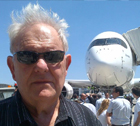The Civil Aviation Safety Authority will be savaged in tomorrow’s official report into the Lockhart River commuter aircraft crash of May 2004. The real story, however, is how CASA will cope with the next 18 months.
If the authority couldn’t identify a scandalous absence of safety culture in a tiny aviation enterprise, Transair, before one of its Metroliners killed all 15 people on board by flying into a mountain while approaching an airstrip, how will it handle the following unprecedented demand for air safety administration and enforcement?
Between now and August next year, at least two new airlines will apply for Australian air operator certificates or AOCs. They are the unnamed Virgin Blue long-haul carrier, which starts flying to America by about August 2008, and Tiger Airways Australia, due to challenge the cosy Qantas/Virgin Blue carriers by December.
And five new types of airliners are due to enter service in the same period, culminating in an unprecedented triple dead heat next August by the 500-seat Airbus A380 for Qantas, the 300-seat Boeing Dreamliner 787 for Qantas subsidiary Jetstar, and the roomier 300-seater Boeing 777-300ER for Virgin Blue’s independently run trans-Pacific operation.
Charter operator SkyAirWorld is about to put Australia’s first 70-passenger Embraer E-170 jet into service, Virgin Blue starts a large scale introduction of the type this August, and AirNorth becomes the third operator of the type in less than a year around October.
Commuter carrier Macair introduces the latest version of the 50-seat European ATR42-500 turbo prop next month to Queensland, and another Queensland charter firm, Jetcraft, introduces three similar ATRs in October.
Any of these new types, let alone the giant A380, is a major test of the CASA capabilities so abundantly shredded in tomorrow’s Australian Transport Safety Bureau report into the Lockhart River disaster, Australia’s worst air crash in 40 years.
On top of that, Skywest in Perth will seek to vary its AOC to include Airbus A320s as well as its current fleet of Fokker F50s. However, a CASA spokesman says there is no connection between this amazing workload and its safety responsibilities in relation to Transair.
He says CASA has spent years carefully planning the deployment of resources to deal with the challenges of the A380 and 787 Dreamliners, and the more recent surge in fleet changes at Virgin Blue and among the smaller operators.
Tomorrow’s ATSB report does not explain conclusively why the Metroliner flew at high speed in rain clouds into a mountain under the control of pilots who clearly thought they were somewhere else as they executed a bad weather approach to Lockhart River.
The voice recorder was useless. However, the turbo prop airliner appears to have been free of any mechanical faults that might have readily explained the crash.
Just like the Garuda disaster, the focus is on pilot standards and training, for which the airline is responsible for maintaining and the safety regulator is responsible for enforcing.
Tomorrow’s ATSB report comprises around 300 pages of appendices and 200 pages of findings. About one-third of those are devoted to the failings of CASA in relation to inaction over Transair safety deficiencies in the years and months before the crash, while the public record and a grilling of CASA officials in a Senate committee room has already exposed its inability to promptly inform the public of concerns about the operator that arose after the crash.
There is a long history of conflict between CASA and the ATSB over safety enforcement, and this whole new chapter is about to land in public when CASA enters a period of unprecedented demands on its resources.








Crikey is committed to hosting lively discussions. Help us keep the conversation useful, interesting and welcoming. We aim to publish comments quickly in the interest of promoting robust conversation, but we’re a small team and we deploy filters to protect against legal risk. Occasionally your comment may be held up while we review, but we’re working as fast as we can to keep the conversation rolling.
The Crikey comment section is members-only content. Please subscribe to leave a comment.
The Crikey comment section is members-only content. Please login to leave a comment.